Cheese Glossary: A Glossary Of The Different Cheese TypesPage 7: Cheese Glossary M To N This is Page 7 of an 12-page article. Click on the red links below to visit other pages. This glossary is protected by copyright and cannot be reproduced in whole or part. You are welcome to link to it.
|
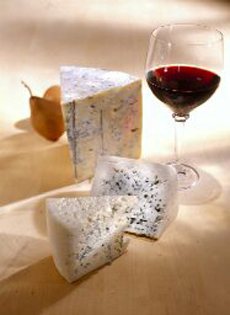 Without mold, there would be no blue cheese. Photo of Gorgonzola and Buttermilk Blue courtesy Wisconsin Milk Marketing Board. |
|
| MASCARPONE
This ultra-rich, extremely smooth, slightly sweet fresh cheese is called “Italian cream cheese.” However, the distinction is only half correct: While mascarpone is made from the cream of cow’s milk, no cheese starter or rennet is used in its production. Mascarpone is made by draining the moisture from heavy cream using a small amount of citric acid and finely woven cloth. The result is similar to Devon Cream or Clotted Cream. Mascarpone is native to the Lombardy region of Italy, which is also home to the town of Gorgonzola. Incorporated into recipes as an ingredient (tiramisu is one of the most famous), it also makes simple yet luscious desserts, served with fruit and biscuits like gingersnaps and strawberries, or as a topping for fresh berries, poached fruit or compote. Use it to stuff figs, dates or dried apricots (sprinkle with chopped pistachios), or as the filling for cookie sandwiches. Or, fill tart shells and top the mascarpone with fresh or dried fruit. The name is said to date back to the 16th century, when a visiting Spanish dignitary tasted it and declared it “mas que bueno,” better than good. He was correct!
|
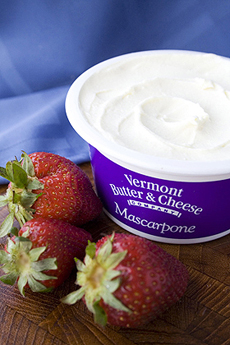 Mascarpone from Vermont Butter & Cheese Company. Read our full review. |
|
| MATURATION or RIPENING
Although some cheeses, once drained, are consumed fresh, others require some time to mature. To do this, they are placed on racks in the hâloir, a cold room which is well ventilated, with humidity of 80%. The cheeses are then regularly turned by hand. The curd slowly develops a rind, which, depending on what bacteria have been used, develops a fine layer of surface mould, which may be white, yellow or brown. The temperature of the air inside the hâloir influences the taste of the cheeses. The cheesemaker monitors their maturation by touch, sight, smell and taste. Maturation can last from several days to several weeks to several years, in the case of hard aged cheeses like Parmesan and Pecorino. Maturity is distinguished externally by the color and the aspect of the cheese rind. Internally, the paste becomes more dry and compacted. |
 Cheeses ripening in a hâloir. Photo courtesy of MorgueFile.com. Cheeses ripening in a hâloir. Photo courtesy of MorgueFile.com. |
|
| MAYTAG BLUE CHEESE
Handmade in central Iowa, Maytag Blue was one of the first great American farmstead cheeses. It is ripened in caves dug into the rolling hills of the Iowa countryside, just as Roquefort is ripened in caves (though naturally-occurring) in southwest France. However, Maytag is a cow’s milk cheese, while Roquefort is made from sheep’s milk. Maytag Blue Cheese is made by the same family that produces washing machines. Fritz Maytag, son of Frederick Louis Maytag, founded the Maytag Dairy, and also owns the Anchor Brewing Company. Perhaps not coincidentally, the cheese pairs well with a medium-bodied ale or lager, or a glass of sweet wine.
|
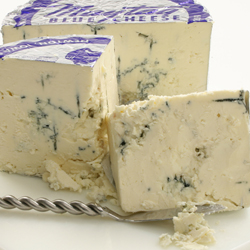 You can buy Maytag Blue at stores nationwide and at iGourmet.com. |
|
| MEMBRILLO
Membrillo is a semisoft cheese condiment made from quince. It is made in loaves, and sliced to serve on cheese platters. A relative of the apple and the pear, quince is high in pectin, and the resulting paste has the consistency of a thick jelly. It has a sweet and tart taste and looks somewhat like a dense fruit gelatin dessert. Any salty or blue cheese pairs well with membrillo, but it works best with Spanish cheeses like Roncal, Mahón or Manchego. See more cheese condiments and suggested pairings. |
 Membrillo from ForeverCheese.com. |
|
| MICROORGANISMS
Yeasts and other fermenting agents present in milk and milk curd. They can be wild and naturally occurring or cultured and introduced.
|
||
| MOLD Mold is a member of the fungus family. It can be on the surface of cheese (such as the fluffy white bloomy rind cheeses—which are somewhat reminiscent of mushrooms) or can be developed internally. Surface molds are the result of cheese being treated with the Penicillium candidum or Penicillium camemberti spore. Internal molds are very different, and are created by the introduction of Penicillium glaucum or Penicillium roqueforti spores, both used to create blue-veined cheeses. Certain French goat milk cheeses develop a natural bluish surface mold, and some of the newer double crème cheeses like Blue Castello, Bavarian Blue and Duet have both a surface mold and an internal mold. Originally, the molds that made these cheeses were naturally occurring, as in the Roquefort caves. Today, much of the mold is manually introduced by the cheesemaker to guarantee success.
|
||
| MOLD-RIPENED CHEESES
These are soft cheeses, not pressed, that are salted and covered with the mold spores Pennicillium candidum (white) and Pennicillium glaucum (grey). The spores use the proteins and fats in the cheese to ripen it from the outside, creating a white rind. The mold acts on the proteins in the curds, breaking them down into more basic components, creating a liquid texture, a more complex flavor and an aroma. Examples include Brie, Camembert and goat cheeses. |
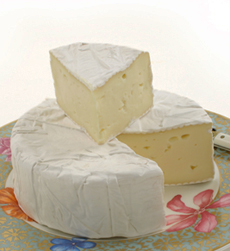 Brie from iGourmet. |
|
| MONASTERY CHEESES or TRAPPIST CHEESES Certain cheeses were originally developed by monks and are known as monastery cheeses. The majority are of the washed rind variety. Port Salut, Saint Paulin, Esrom and Havarti are examples, as well as several mountain cheeses including Beaumont and Reblochon.
|
||
| MOUNTAIN CHEESE
According to Caseus Montanus, an international association of mountain cheese producers, a mountain cheese is one produced and aged above 800 meters (approximately 2500 feet). Most are made in France, Italy, Spain and Switzerland. A Vermont-made mountain cheese, Tarentaise, was named “Best Farmstead Cow’s Milk Cheese” at the 25th American Cheese Society Conference, for American-made cheeses. According to ArtisanalCheese.com, scientific studies on the flavor profile of mountain cheeses have found as many as 100,000 micro-organisms in the flora of the high altitude mountains, as compared to less than 10,000 microorganisms in lower prairie altitudes. This intensity of micro-organisms is responsible for the deep and complex flavors of mountain cheeses. Popular mountain cheeses (cow’s milk, except as noted) include Appenzeller (Swiss), Beaufort (French), Bleu des Basques Brebis (French, sheep’s milk blue cheese), Cantalet (French), Comté (French), Fontina Val d’Aosta (Italian), Fourme d’Ambert (French, blue cheese), Gruyère (French and Swiss), Hoch Ybrig (Swiss), Sbrinz (Swiss), Tête de Moine (Swiss) and Valdeón (Spain, blue goat’s milk cheese). Cheeses made in the French or Swiss Alps are also called Alpine cheeses. |
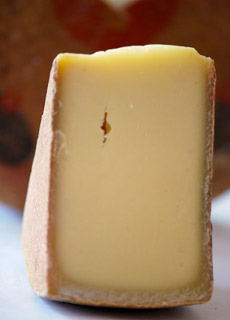 Hoch Ybrig is a mountain cheese made from cow’s milk in Canton Schwyz, Switzerland. It is washed in a white wine brine, which provides additional complexity. Buy it at ArtisanalCheese.com. Photo courtesy Artisanal Cheese. |
|
| MOZZARELLA or MOZZARELLA DI BUFALA Legally, in Italy, mozzarella is made from the milk of the water buffalo, and is mozzarella di bufala; cow’s milk mozzarella is known as fior di latte, “the flower of the milk.” Water buffalo, native to Asia, were brought to Italy in the 1400s. Water buffalo’s milk is higher in both fat and protein than cow’s, yielding 1.6 times more cheese. It also lacks the yellow pigment, carotene, found in cow’s milk, so mozzarella di bufala is pure white. Almost all American-made mozzarella is from cow’s milk. Mozzarella is a pasta filata, a spun paste. Like other cheeses, it begins with a rennet-curdled milk. But unlike other cheeses, whose curds are then gathered and molded, mozzarella curds are plunged into hot whey or lightly salted water, kneaded and pulled to develop the familiar stretchy strings (pasta filata), then shaped into the desired form (mozzarella, provolone, scamorza). |
 Black Truffle Mozzarella from iGourmet. |
|
| MUENSTER CHEESE Muenster cheese is a mild American cheese, not to be confused with the pungent Munster cheese from the Alsace region of France. It is the evolution of the cheese made by European immigrants tot the U.S. in the 1880s. While some artisan cheesemakers make round aged muensters in the alsatian style, most are factory-made loaves meant to be eaten young as a sandwich, cooking or snack cheese (it is made in flavored varieties including caraway, cranberry and hot pepper). It is a great melter for grilled sandwiches, burgers and other dishes. While European-style munster is a washed-rind cheese, in U.S. the rind is generally not washed (washing provides more pungency), but annatto is used to provide an coating. The paste is semi-soft, smooth and elastic. |
 Domestic muenster. Photo courtesy WisconsinCheeseman.com. |
|
| MUNSTER CHEESE Munster cheese is an assertive cheese believed to that originated in the eastern Vosges Mountains of the Alsace region of France. It is a monastery cheese that dates to the early Middle Ages; the name munster derives from the local dialect for monastery (in Latin, monasterium). Made of unpasteurized cow’s milk in small and large flat wheels, munster is the only cheese native to Alsace. A washed rind cheese, Munster has a very pronounced, powerful aroma. In the five-week to three-month aging period, the rind is periodically washed with brine. It is rubbed by hand with a cloth moistened by a brine solution of rock salt and water (the salt inhibits the growth of mold). This added moisture encourages the development of the bacteria that gives munster its characteristically strong flavors and smells, as well as its “red” rind (actually orange). When ripe, munster has the aroma of porcini mushrooms and the runny interior evokes truffles. (When young, the paste is creamy.) Washed rind cheeses, also known as “stinky” cheeses, are popular with connoisseurs for their depth of flavor and character. Other popular examples include such as Limburger, Livarot, Pont L’Eveque and Taleggio. Munster has been AOC-protected (Appellation d’Origine Contrôlée) since 1969. Serve with a spicy Alsatian Pinot Gris, a Riesling, sherry or a Belgian ale. |
 Alsatian Munster. Available at ArtisanalCheese.com. |
|
| MUSHROOMY A description of the flavor and aroma of certain soft and semi-soft cheeses, particularly members of the Brie and Camembert family.
|
||
| NATURAL RIND CHEESES These cheeses have rinds that self-form during the aging process. Generally, no molds or microflora are added, nor is washing used to create the exterior rinds. Those that do exhibit molds and microflora in their rinds get them naturally from the environment. Most natural rind cheeses are aged for many weeks to develop their flavor as well as the rinds, and many are made from raw milk. Examples include many “tomme” style cheeses such as tomme de Savoie and mimolette, Stilton and Lancashire.
|
||
| NUTTY Often referring to hazelnut, a flavor that occurs naturally in some cheeses. Continue To Page 8: Terms Beginning With O & P Return To The Article Index Above
|
 Mimolette, a natural rind cheese with an extraordinarily beautiful color to match its fine flavor, is available at iGourmet. |
|
Last Updated May 2018
© Copyright 2005-2025 Lifestyle Direct, Inc. All rights reserved. All images are copyrighted to their respective owners.